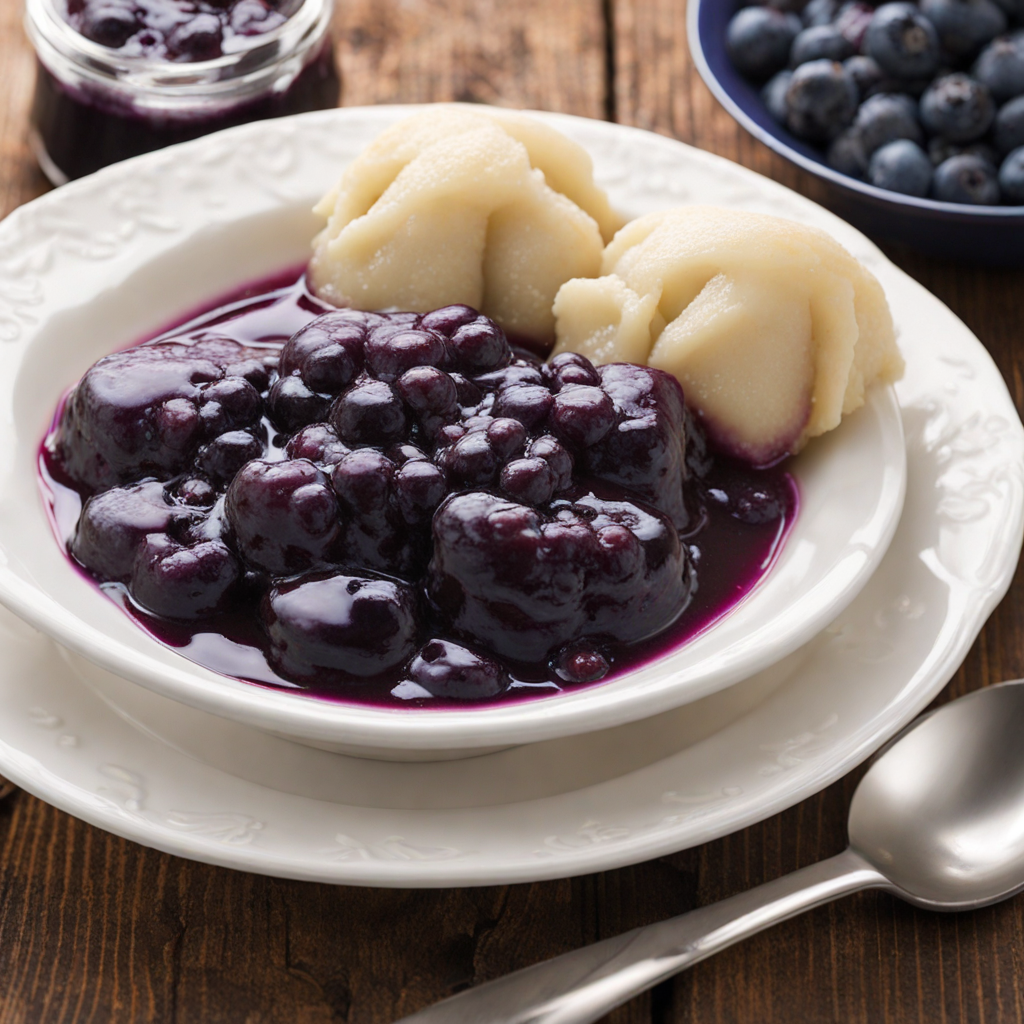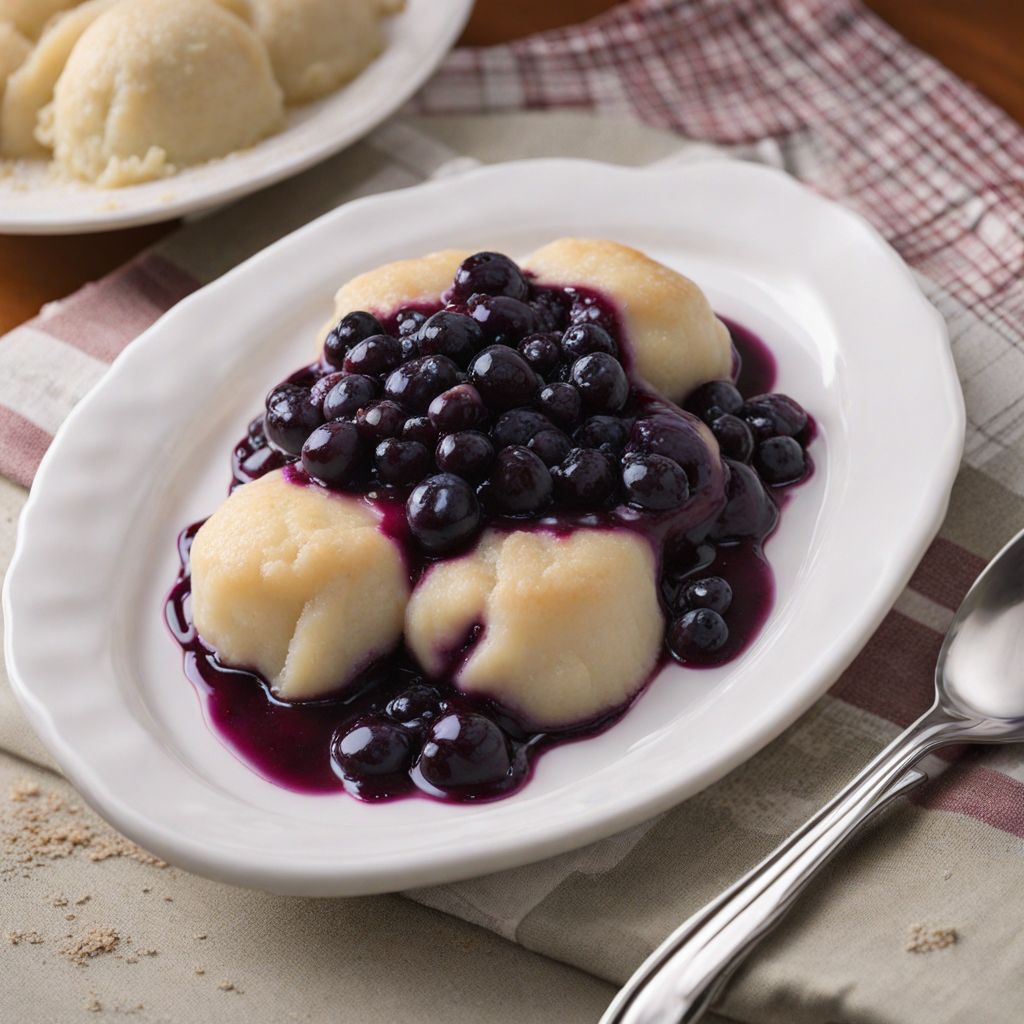Blueberry Grunt
Blueberry Grunt is a delightful dessert that hails from Canada, particularly popular in the Maritime provinces. This unique dish combines the sweetness of fresh blueberries with a light, fluffy dumpling-like topping. The blueberries are typically simmered with sugar and a hint of lemon juice to create a luscious, syrupy base that bursts with flavor. As the dish cooks, the dumplings rise and soak up the juicy goodness of the berries, creating a comforting and satisfying combination that is both fruity and slightly tart. The preparation of Blueberry Grunt is relatively simple, making it an accessible treat for home cooks. The blueberries are first cooked on the stovetop until they release their juices and become tender. A mixture of flour, baking powder, milk, and butter is then blended together to form the dumplings, which are spooned on top of the bubbling fruit mixture. As the dish simmers, the dumplings puff up, creating a delightful contrast to the soft, warm blueberries beneath. The result is a rustic, one-pot dessert that embodies the essence of Canadian comfort food. Served warm, Blueberry Grunt is often enjoyed with a scoop of vanilla ice cream or a dollop of whipped cream, enhancing its indulgent appeal. The vibrant color of the blueberries against the pale dumplings makes for an eye-catching presentation, perfect for family gatherings or casual get-togethers. Each bite offers a burst of berry flavor followed by the soft, pillowy texture of the dumplings, making it a memorable way to experience a taste of Canada's culinary heritage.
How It Became This Dish
The History of Blueberry Grunt: A Canadian Culinary Treasure Blueberry grunt is a delightful dessert that hails from Canada, particularly associated with the Maritime provinces of Nova Scotia and New Brunswick. As with many traditional dishes, its history is steeped in local culture and the practicalities of life in the region, making it a dish that is as rich in flavor as it is in heritage. #### Origins The origins of blueberry grunt are closely tied to the landscape of Canada’s East Coast. The region is abundant in wild blueberries, which thrive in the area’s acidic soil and cool climate. Indigenous peoples, particularly the Mi'kmaq, were the first to harvest these berries, utilizing them in various forms of sustenance long before European settlers arrived. Blueberries were not only a food source but also held cultural significance, often used in traditional medicines and rituals. As European settlers began to colonize the region in the 17th and 18th centuries, they brought with them their own culinary traditions, which began to meld with those of the Indigenous populations. The term "grunt" itself is believed to derive from the sound made when the bubbling fruit mixture is cooked, or from the British colonial term for a type of pudding. Thus, blueberry grunt emerged as a sweet, comforting dish that utilized the abundant local ingredients. #### Cultural Significance Blueberry grunt has come to symbolize comfort and home-cooked meals in Canadian maritime culture. It reflects the resourcefulness of early settlers who needed to make the most of what their environment provided. The dish typically consists of a stewed blueberry filling topped with a biscuit-like dough, which is then steamed rather than baked. This method of cooking is reminiscent of other regional dishes such as "slump" and "cobbler," which also feature fruit and dough but differ in preparation and texture. The preparation of blueberry grunt often takes place in the summer months when blueberries are at their peak. Families would gather to pick berries, creating a communal experience that fostered bonds and traditions. This seasonal aspect added to the dish’s significance, as it became associated with family gatherings and celebrations, particularly in rural communities. It has often been served at picnics and potlucks, further embedding it into the social fabric of Canadian life. #### The Recipe and Its Evolution The basic recipe for blueberry grunt has remained largely consistent over the years, rooted in simplicity and the use of fresh ingredients. The traditional method involves simmering blueberries with sugar and a touch of water until they begin to bubble, releasing their juices. A mixture of flour, baking powder, milk, and sometimes sugar is then dropped onto the bubbling fruit. The pot is covered, allowing the dumplings to steam until cooked through. The result is a warm, comforting dessert that is both sweet and tart, often served with a scoop of vanilla ice cream or a dollop of whipped cream. Over time, variations of blueberry grunt have emerged, reflecting changes in taste and the influence of modern culinary practices. Some cooks have experimented with different types of berries, such as raspberries or blackberries, while others have added spices like cinnamon or nutmeg to enhance the flavor profile. More contemporary recipes may incorporate elements such as oat flour or alternative sweeteners, catering to modern dietary preferences. In recent years, there has been a resurgence of interest in traditional foods, driven by a growing appreciation for local and sustainable eating. Chefs in Canada have started to highlight classic recipes like blueberry grunt on their menus, celebrating its cultural heritage while infusing it with contemporary flair. Food festivals and events focused on Canadian cuisine often feature blueberry grunt, showcasing its role in the nation’s culinary identity. #### Blueberry Grunt in Contemporary Culture In the digital age, blueberry grunt has found a new audience through social media platforms, where food photography and recipe sharing have become a cultural phenomenon. Home cooks and food bloggers have embraced the dish, sharing their own interpretations and adaptations, which has helped to keep this traditional recipe alive in a rapidly changing culinary landscape. Furthermore, as the interest in Indigenous food sovereignty grows, there has been a renewed emphasis on the historical significance of ingredients like blueberries in Indigenous cultures. This has led to a greater appreciation for the origins of dishes like blueberry grunt and the stories they tell about the people and places they come from. Today, blueberry grunt stands as a testament to Canada’s rich culinary heritage. It is more than just a dessert; it is a symbol of community, resilience, and the connection between people and the land. The act of gathering blueberries and preparing this dish embodies the spirit of sharing and togetherness that is fundamental to Canadian culture. #### Conclusion Blueberry grunt is a delicious embodiment of the history and culture of Canada’s Maritime provinces. Its origins are rooted in the land and the traditions of Indigenous peoples and settlers alike. Over the years, it has evolved while maintaining its comforting essence, showcasing the adaptability of traditional recipes in modern times. As we savor each spoonful of blueberry grunt, we partake in a culinary narrative that spans generations, reflecting the lives of those who came before us and the landscape that nurtured them. In a world that increasingly values the stories behind our food, blueberry grunt serves as a delicious reminder of the importance of heritage, community, and the simple pleasures found in a shared meal. Whether enjoyed at a summer gathering or as a cozy treat on a winter’s night, blueberry grunt continues to warm hearts and bring people together across Canada and beyond.
You may like
Discover local flavors from Canada







